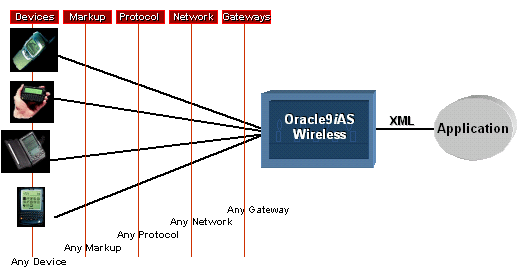Release 2 (9.0.2)
Part Number A90485-02
Home |
Solution Area |
Contents |
Index |
| Oracle9iAS Wireless Developer's Guide Release 2 (9.0.2) Part Number A90485-02 |
|
Each section of this document presents a different topic. These sections include:
XML stands for eXtensible Markup Language. It can be best described as portable data. XML was recommended by the World Wide Web Consortium (W3C) in 1998. Since then, XML has quickly become the standard way to identify and describe data on the Web. Namespaces were added to XML in 1999. Namespaces describe a way to distinguish between two XML elements with the same name in different documents. This prevents the possibility of collision between element names among documents.
XML is a subset of SGML (Standard Generalized Markup Language), optimized for delivery over the Web. An XML document consists of a single root element. Every start-element must have a matching end-element (this property of XML documents is called well-formedness). Additionally, attributes of an element must be guarded by quotes.
XML documents can also be subjected to structural and global constraints, which are described by schema languages (such as document type definition [DTD] and XML Schema). An XML document is said to be valid if it satisfies the constraints described by a schema language. DTD is a weak schema language defined as part of the XML 1.0 specification and does not follow XML syntax. XML schema was recommended by W3C in 2001. XML schema is a powerful schema language that specifies a rich set of constraints. The XML schema itself is an XML document.
HTML tags elements in Web pages for presentation by a browser
(for example, <bold>Oracle</bold>).
XML tags elements as data
(for example, <company>Oracle</company>).
You can use XML to give context to words and values in Web pages, identifying them as data instead of simple textual or numeric elements. Well formedness of XML documents makes XML processing easier and more efficient.
Consider the following XML document:
<address> <first-name>Chandra</first-name> <last-name>Patni</last-name> <street>400 Oracle Parkway</street> <zip>94065</zip> </address>
In this example, the element names self-describe the data they encapsulate. This XML document can be transformed into HTML using another XML document called an XSL stylesheet. This same XML document can be transformed into WML using another XSL stylesheet. The document can then be displayed on a WAP device. This ability of XML makes it suitable for representing and delivering portable data to various devices. XML content are also future-proof; another stylesheet can be used to deliver the content to any future device. Therefore, XML transformation can be done programmatically on-the-fly. Oracle9iAS Wireless provides a framework to do exactly the same thing. It allows content represented by XML format defined by an Oracle9iAS Wireless schema to deliver content to any device at any time.

At the core of Oracle9iAS Wireless, XML from an application is transformed to device-specific markup languages using XSL transformation. Oracle9iAS Wireless provides a framework for interacting with applications and transforming XML to device-specific markup languages. Oracle9iAS Wireless provides an XML schema, elements of which can be used to build user interfaces to render application content to any device.
|
|
 Copyright © 2002 Oracle Corporation. All Rights Reserved. |
|